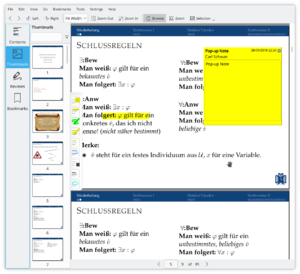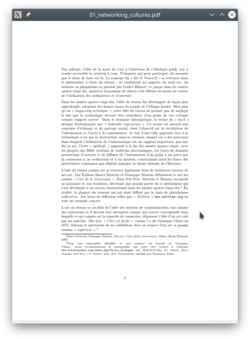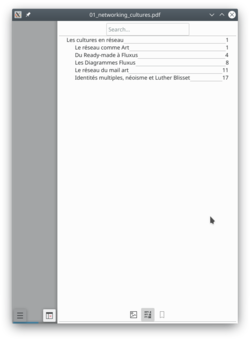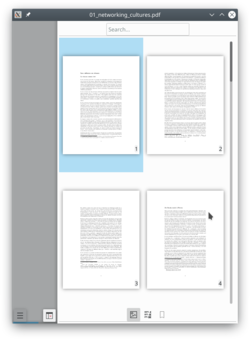Okular/fr: Difference between revisions
Updating to match new version of source page |
Updating to match new version of source page |
||
| Line 8: | Line 8: | ||
==Contexte== | ==Contexte== | ||
Its development began as part of Google's Summer of Code program. The description of the project can be found at [https://web.archive.org/web/20080921165821/https://developer.kde.org/summerofcode/okular.html KDE Developer's Corner]. | |||
'''Okular''' combine les fonctionnalités excellentes de [[Special:myLanguage/KPDF|KPDF]] avec la possibilité de prendre en charge différentes sortes de documents, tels que PDF, Postscript, DjVu, CHM, et d'autres. | '''Okular''' combine les fonctionnalités excellentes de [[Special:myLanguage/KPDF|KPDF]] avec la possibilité de prendre en charge différentes sortes de documents, tels que PDF, Postscript, DjVu, CHM, et d'autres. | ||
| Line 24: | Line 24: | ||
== Mobile Version == | == Mobile Version == | ||
Okular has a mobile version since version 0.16 release in February 2013 <ref>[https://okular.kde.org/news.php Release information]</ref>. The first version was based on the [https://community.kde.org/Plasma/Active active] framework. The mobile viewer was then ported to Kirigami in 2016 by Marco Martin<ref>[https://phabricator.kde.org/R223:eb1f73800e83b11e4a5ae93ac069893aa88f0eaa | Okular has a mobile version since version 0.16 release in February 2013 <ref>[https://okular.kde.org/news.php Release information]</ref>. The first version was based on the [https://community.kde.org/Plasma/Active active] framework. The mobile viewer was then ported to Kirigami in 2016 by Marco Martin<ref>[https://phabricator.kde.org/R223:eb1f73800e83b11e4a5ae93ac069893aa88f0eaa Commit port mobile version from plasma-framework to kirigami]</ref> and finally to Kirigami2 in 2017<ref>[https://phabricator.kde.org/R223:caf8820cf773316ce41d9a8c1f7357b3ffc3ef86 Commit port mobile version from kirigami to kirigami2]</ref>. | ||
The mobile version doesn't support all features | The mobile version doesn't support all features from the desktop version, but provide better touch support and a mobile interface. | ||
[[File:Okular_mobile_pdf_view.png|250px]] | [[File:Okular_mobile_pdf_view.png|250px]] | ||
| Line 49: | Line 49: | ||
By default, Okular follow the PDF specification and don't allow copying text from DRM protected files. However, there is an option in the settings to disable DRM limitations in <menuchoice>Settings -> General -> Program Features -> Obey DRM limitations</menuchoice> | By default, Okular follow the PDF specification and don't allow copying text from DRM protected files. However, there is an option in the settings to disable DRM limitations in <menuchoice>Settings -> General -> Program Features -> Obey DRM limitations</menuchoice> | ||
There was a small controversy in the Debian bug tracker a long time ago, about the default choice to Obey DRM limitations<ref>[https://lists.debian.org/debian-devel/2009/05/msg00879.html DRM and Okular in Debian bug tracker]</ref><ref>[https://lwn.net/Articles/335415/ DRM and Okular in LWM]</ref>. | There was a small controversy in the Debian bug tracker a long time ago, about the default choice to Obey DRM limitations<ref>[https://lists.debian.org/debian-devel/2009/05/msg00879.html DRM and Okular in Debian bug tracker]</ref><ref>[https://lwn.net/Articles/335415/ DRM and Okular in LWM]</ref>. The choice was then [https://tsdgeos.blogspot.com/2009/06/okular-pdf-and-drm.html explained] by an Okular/KPdf developer<ref>[https://tsdgeos.blogspot.com/2009/06/okular-pdf-and-drm.html Okular, PDF and file permissions]</ref>. | ||
=== PDF Signature and certificate === | === PDF Signature and certificate === | ||
Okular can verify if a PDF certificate is valid. But you can not yet create new signature. See [https://tsdgeos.blogspot.com/2019/01/okular-pdf-signature-certificate.html release note] for more information. | Okular can verify if a PDF certificate is valid. But you can not yet create a new signature. See [https://tsdgeos.blogspot.com/2019/01/okular-pdf-signature-certificate.html release note] for more information. | ||
== More Information == | == More Information == | ||
Revision as of 21:00, 3 February 2019
Qu'est-ce qu'Okular ?
Okular est un visualiseur de documents universel développé par KDE. Okular fonctionne sur plusieurs plates-formes, y compris, mais sans s'y limiter, Linux, Windows, Mac OS X, *BSD, etc.
Vous pouvez suivre le développement sur la page d'accueil du projet.
Contexte
Its development began as part of Google's Summer of Code program. The description of the project can be found at KDE Developer's Corner.
Okular combine les fonctionnalités excellentes de KPDF avec la possibilité de prendre en charge différentes sortes de documents, tels que PDF, Postscript, DjVu, CHM, et d'autres.
La page des formats compatibles contient un tableau décrivant plus en détails les formats pris en charge et les fonctionnalités offertes pour chacun des cas.

En plus de supporter de nombreux formats, Okular offre des fonctionnalités telles que la sélection de texte, l'annotation, l'extraction de fichiers incorporés dans un document, et bien d'autres surprises. Les captures d'écran d'Okular en action peuvent être vues ici.
Vous pouvez parler aux développeurs et aux autres utilisateurs sur IRC, irc.freenode.org canal #okular.
Si vous êtes intéressé pour contribuer à Okular, veuillez contacter l'équipe. Les programmeurs comme les non-programmeurs sont les bienvenus au même titre.
Mobile Version
Okular has a mobile version since version 0.16 release in February 2013 [1]. The first version was based on the active framework. The mobile viewer was then ported to Kirigami in 2016 by Marco Martin[2] and finally to Kirigami2 in 2017[3].
The mobile version doesn't support all features from the desktop version, but provide better touch support and a mobile interface.
You can test the mobile version in your PC by entering
okularkirigami
in your terminal.
Trucs et astuces
Révision de documents / Annotations
Double cliquez sur n’importe quel outil de Révision (F6) vous permet de faire de multiples annotations sans avoir à réactiver l’outil à chaque fois.
Comment garder les annotations que vous avez faites dans le fichier PDF :
Par défaut, Okular range les annotations dans le répertoire data local de chaque utilisateur. Depuis KDE 4.9, on peut d'une manière facultative, les sauvegarder directement dans un fichier PDF en choisissant , afin qu'elles puissent être lues par d'autres visionneuses de PDF. Notez que cette fonction nécessite Poppler 0.20, ou plus récent, pour les documents PDF usuels. Si le document PDF que vous annotez est crypté, cette fonction nécessite Poppler 0.22 ou plus récent.
DRM
By default, Okular follow the PDF specification and don't allow copying text from DRM protected files. However, there is an option in the settings to disable DRM limitations in
There was a small controversy in the Debian bug tracker a long time ago, about the default choice to Obey DRM limitations[4][5]. The choice was then explained by an Okular/KPdf developer[6].
PDF Signature and certificate
Okular can verify if a PDF certificate is valid. But you can not yet create a new signature. See release note for more information.
More Information
- Official KDE documentation
- Okular website
- Okular API documentation
- Okular phabricator project
- Okular git repository



